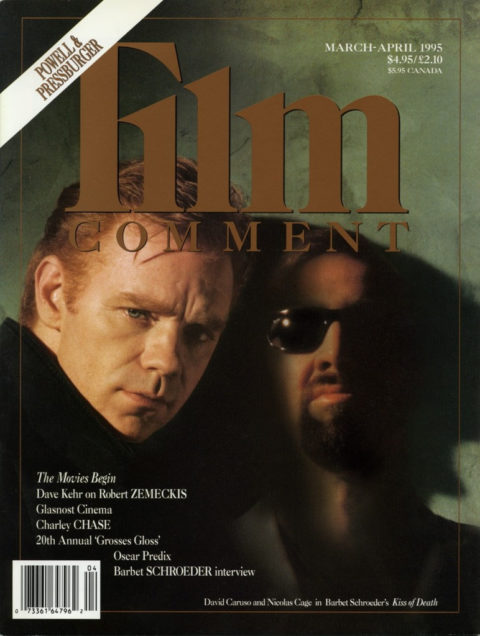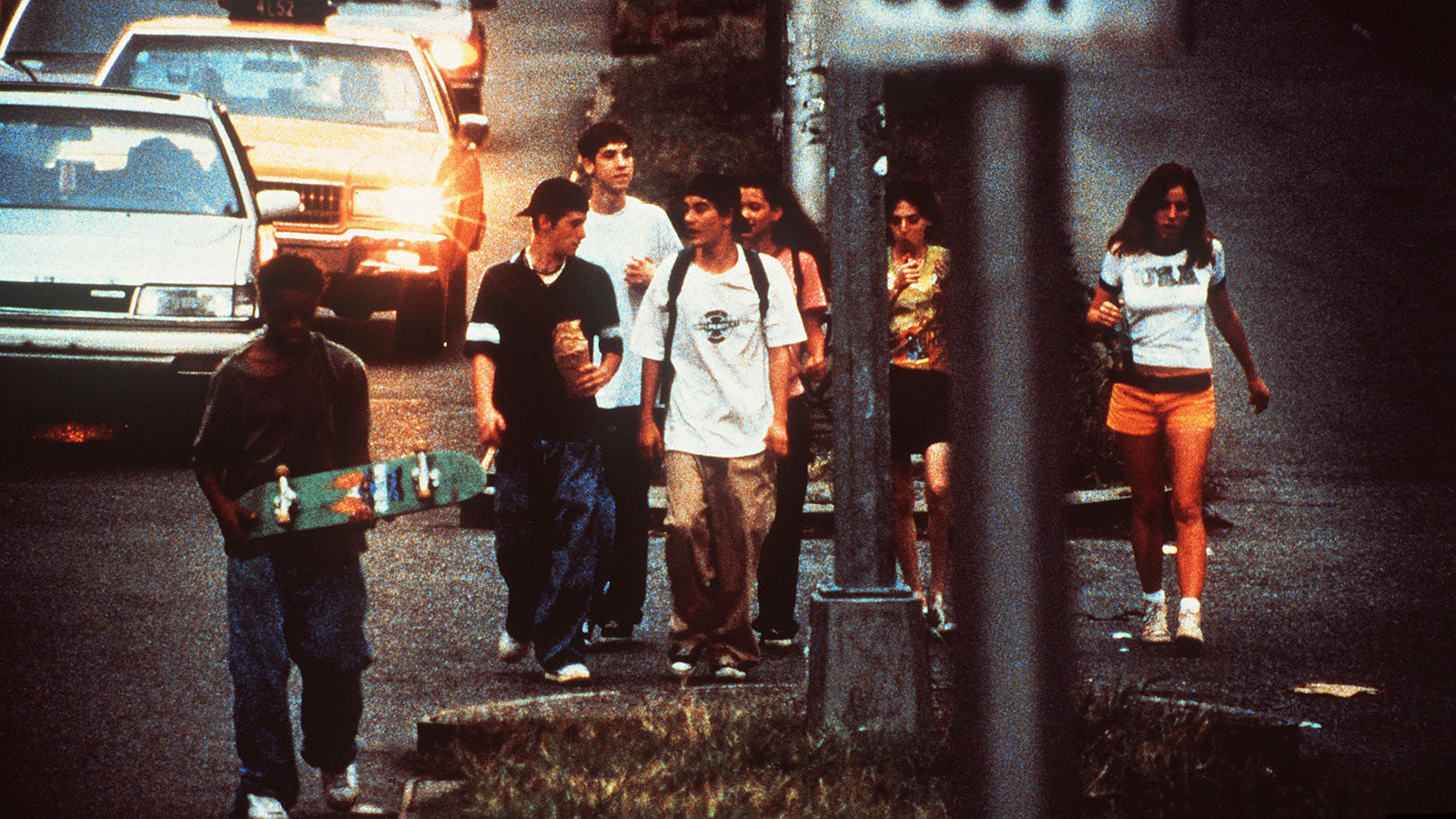
Sundance Kids
The best film of this year’s Sundance Film Festival, and unquestionably one of the most important American films of the year, premiered out of competition and unannounced, as a sneak midnight preview. Larry Clark’s Kids is a stunning artistic achievement—and destined for a ratings controversy to eclipse all others.
Clark is one of the most important photographers of the last quarter-century. His books Tulsa and Teenage Lust are legendary documents of the teen experience at its most extreme, full of guns, drugs, and sex, tinged with stark eroticism, and unnerving in their matter- of-factness. His work has been influential for many, including Gus Van Sant, who executive-produced this film and supplied DP Eric Edwards. Kids is Clark’s translation of his vicarious fascination with adolescent energy into cinematic form, developed with 21-year-old Harmony Korine, whom Clark met one day in Washington Square Park.
Raw, yet precisely structured into an episodic, 24-hour, parallel-action framework, it’s the last possible word in street cinema verite, a devastating portrait of the beauty and amorality of youth, with extraordinary performances from a cast of presumably genuine street kids. Filmed with loose, handheld intimacy—as if Rossellini’s Germany Year Zero had been transposed to New York—the film follows two teenage boys as they make the rounds, hanging out, shoplifting, doing drugs, fighting, and in the case of one of them, Telly, convincing two separate girls in their early teens, at the beginning and the end of the film, to let him take their virginity. Meanwhile, the pair are tracked down by yet another girl who has just discovered she’s HIV+ by Telly.
Clark presents a heartbreaking, unbearable, and disturbingly erotic vision of predatory boys and naive girls, and his unflinching depiction of the abandon of underage sex and drugs may make the film unreleasable. Miramax acquired it, but parent company Walt Disney may not be ready for such strong medicine. Whatever happens, this is a profoundly important and utterly compelling masterpiece.
By comparison, films like Rhythm Thief and The Basketball Diaries stood revealed as the fraudulent, superficial drivel they are. The former, directed by Matthew Harrison from New York’s Lower East Side film collective Film Crash, nevertheless fooled a divided Sundance Jury (Atom Egoyan, Samuel L. Jackson, Darnell Martin, Whit Stillman, and Mirabella reviewer Ella Taylor), who gave it a Special Recognition for Directing. Maybe they thought they were discovering the next Laws of Gravity. Not so.
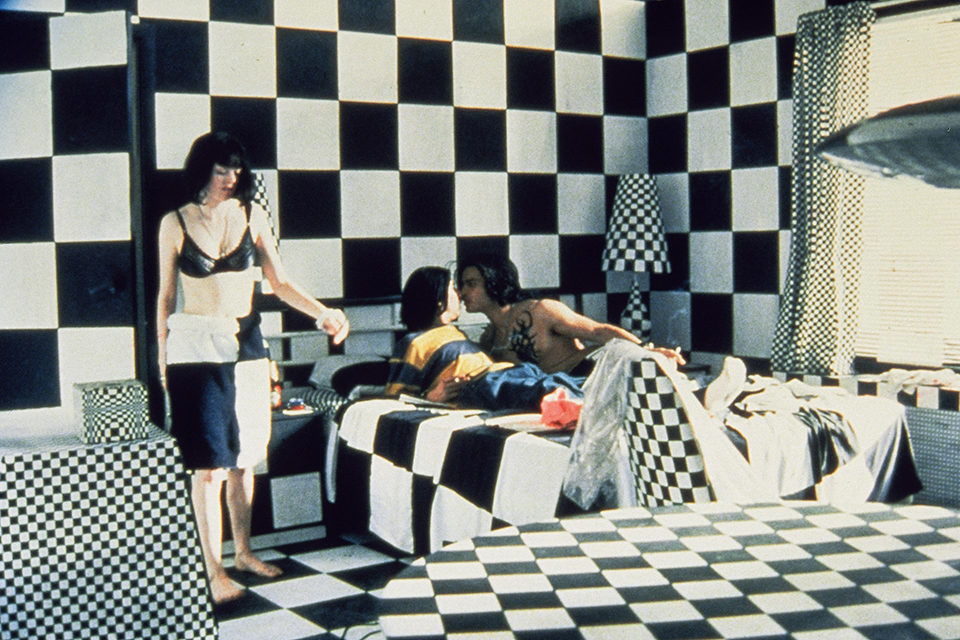
The Doom Generation (Gregg Araki, 1995)
The other half of the Special Recognition for Directing went to James Mangold’s Heavy, which certainly demonstrated a decent level of cinematic intelligence and degree of maturity rare in much of the work in competition. It was shot in upstate New York seemingly in the interstices of Nobody’s Fool, with which it shares not only general location but also production staff and actor Pruitt Taylor Vince. He plays Victor, a cripplingly introverted, overweight, sexually inexperienced chef who develops a crush on a young, attractive, but troubled new waitress at the diner owned by Victor’s overbearing mom (Shelley Winters). It’s de rigueur, even in a relatively unsentimental film like this, that the smalltown lives of ordinary working people are inherently stifled and unfulfilled. But Heavy is a quietly affecting portrait of desperation that resists the temptation to make every scene payoff, or overplay the latent unease and incipient psychosis that lurks at the edge of the story (delicately evoked by Sonic Youth guitarist Thurston Moore’s effectively dissonant score). As an ageing sexpot waitress who attempts to seduce the oblivious and preoccupied Victor, Deborah Harry gives an outstanding performance, blossoming—at last!—into an actor of dimension and substance.
Unarguably the most anticipated out-of- competition premiere was Abel Ferrara’s The Addiction, a kind of vampire Crime and Punishment featuring the ever-great Lili Taylor. She’s a too-serious-for-her-own-good NYU philosophy student who gets bitten by, and herself becomes, a vampire, pausing between victims for bouts of intense philosophical and spiritual introspection. Conflating vampirism and heroin addiction (each a metaphor for the other, depending on whether you’re Ferrara or his screenwriter, former philosophy and theology student Nicky St. John), it is by turns absurd, disturbing, and cryptic, but galvanized throughout with Ferrara’s all-or-nothing boldness and resolve. Ken Kelsch’s sensuous, luminous black-and-white cinematography confirms the promise of his much-imitated work in Bad Lieutenant and, in conjunction with the film’s hypnotic rhythms, captures an extraordinary sense of junkie suspension. This film also reminds us that Ferrara is a master of filming characters in solitude, placing them in charged, unflinching long takes: he gives Taylor the freedom to go extreme, and her risk-taking pays off in a performance of almost possessed fervor.
The movie is an outrageous mix of rap music, vampirism, drug iconography, street lowlife, philosophical pontification (”You want an apology for ethical relativism or something?” demands fellow student Edie Falco), and by all means Christopher Walken, as an eccentric veteran vampire, reprising his blank-gaze-into-the-lens from King of New York. With its scenes of shooting up blood, gushing throat wounds, and full-frontal documentary shots of nude Bosnian victims of genocide, not to mention a climactic vampire feeding frenzy that closes with Taylor’s descent into bloody abjection, the film may be too harrowing for some-but it’s undeniable in its conviction and ultimately a deadly serious consideration of sin, guilt, and redemption. Somebody distribute this film, for God’s sake.
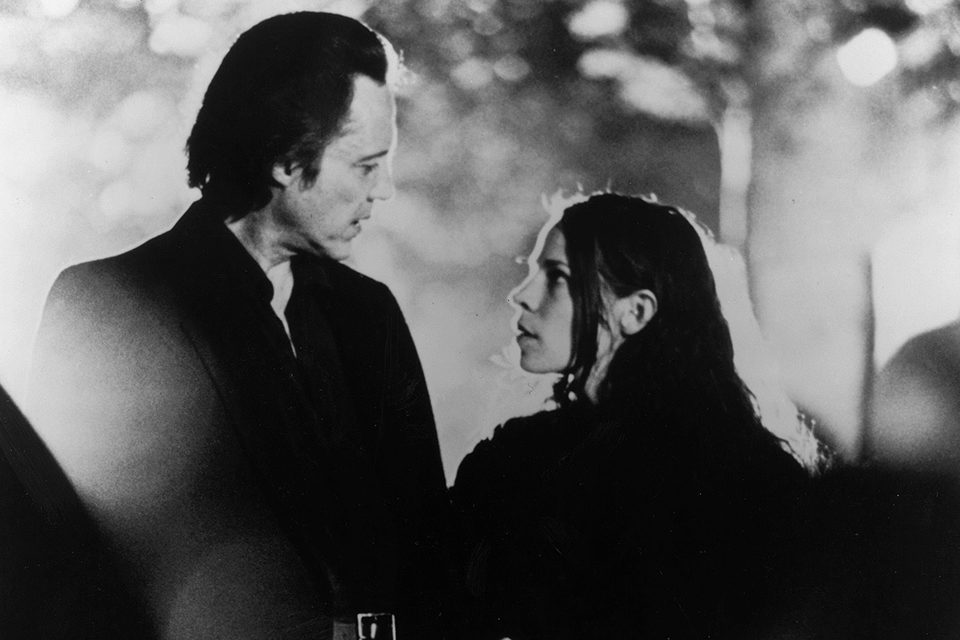
Christopher Walken and Lili Taylor in The Addiction (Abel Ferrara, 1994)
The two other out-of-competition highlights were Todd Haynes’s Safe and Gregg Araki’s The Doom Generation, and no two films could be more formally dissimilar.
Haynes’s is an ultra-controlled study in suburban alienation that engages with and subverts the TV disease-of-the-week genre by playing off medical mystery against a clinical study in Stepford Wives patriarchal subordination and consumerist conformity. The film is divided into two parts; in the first, self-described “homemaker” Carol (Julianne Moore) gradually falls prey to MCS (multiple chemical sensitivity) syndrome; in the second, she goes to stay for an extended period at a rural treatment center where she initially seems to improve but ultimately continues to decline. Haynes’s coup here is to reject the oppositional logic of genre that would make this alternative to the oppressive medical establishment the answer to all Carol’s physical and emotional problems. On the contrary, Haynes regards the treatment center as equally toxic in its own way, its glib New Age insistence upon each sufferer’s complicity in her own affliction part of an insidious recovery culture ideology that fosters its own alternate forms of conformism, psychological dependency, and estrangement.
Safe establishes its visual authority immediately, and possibly too well: its mise-en-scene is dominated by antiseptic, symmetrical compositions of highly organized suburban interiors, the characters literally squeezed to the edges of the frame by their environments. We’ve been here before—Antonioni, Akerman, Haneke, Egoyan, Cronenberg, Pakula—and in following his formalist conceits to their logical conclusions, Haynes overstates and overextends things. Still, it’s exhilarating to see a young indie commanding the medium so unapologetically when current fashion seems to favor a supposed naturalism that amounts to flat awkwardness and absence of technique.
Forgivable overkill also characterizes The Doom Generation. “Photographed on location in Hell” reads a closing credit on Araki’s latest outrage, intended, he says, as “the gayest heterosexual movie ever made” and designed to reproduce the experience of “watching late-night TV and falling asleep.” A mutant movie, equal parts horror flick, romantic triangle, and road film, it’s The Living End remade as Night of the Living Dead, Weekend, and Jules et Jim. Unfortunately preempted by Natural Born Killers, its trio go on the run, fleeing from one nightmarish episode—their accidental slaying of a shotgun-wielding Korean deli clerk—to the next, trapped in a demented cycle of violent encounters that follow a fixed pattern: mistaken identity resulting in accidental murder and flight. Each time, the three find refuge in a motel, have sex, then go out in search of junk food-and walk into yet another violent scenario.
To use current terminology, Araki goes gross-out with a vengeance: the film is a gleeful panic of severed heads, spurting arteries, rape, and castration , which, combined with Araki’s penchant for shock one-liners (”I feel like a gerbil swimming around in Richard Gere’s butt”), jokey cameos (Heidi Fleiss as a convenience-store clerk, cast members from The Brady Bunch and The Love Boat), pop nihilism, trademark willfully bad compositions, garish lighting, and seemingly amateurish performances, confirm him as film’s most authentic punk rock sensibility. This is his first film in 35mm, but he doesn’t let that get in his way.
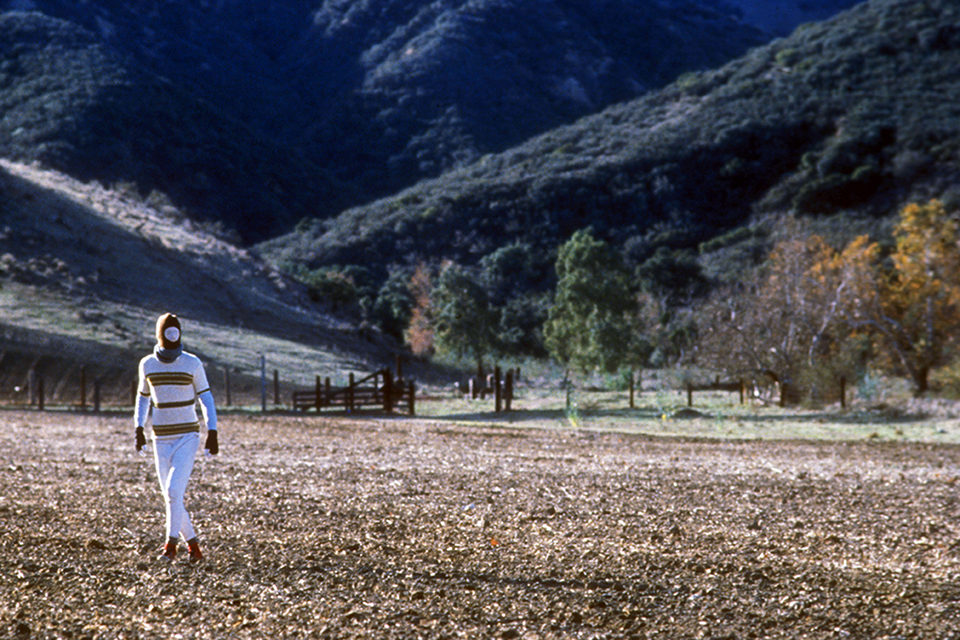
Safe (Todd Haynes, 1995)
Of the films in the Dramatic competition, the best were Postcards from America, Nadja (both noted in previous issues), and Rebecca Miller’s Angela, a delicate and haunting investigation of the fantasy life of a lO-year-old girl who coopts her 6-year-old sister into her elaborately ritualized neo-Catholic cosmology of angels and devils, all tinged with early stirrings of sexuality. Imaginative experience is as powerul a force in their lives as lived experience—if not more so—providing ambiguous refuge from the world of their neurotic, unstable mother and remote but well-meaning father. The film engages with contemporary cultural interest in the iconography of girlhood and the darker corners of children’s experience, most obviously Sally Mann’s photographs. But where Mann views her children externally, with an almost clinical, alien eye, Angela is a wholly subjective film, projecting its heroine’s consciousness in a poetic, stylized mode reminiscent of Jane Campion. Impressively photographed by the versatile Ellen Kuras (Postcards from America, Swoon) and designed by Danny Talpers, Angela is realized in translucent, pale tones and ambient soft light, and moves with ethereal ease toward its poignant, unexpected resolution.
Audience favorite and winner of the Grand Jury Prize for a dramatic film , The Brothers McMullen is an agreeable, modestly realized Long Island Irish-Catholic reinvention of the Eric Rohmer Moral Tale (particularly Ma Nuit chez Maud). In it, three brothers—Jack, a married gym teacher; single screenwriter Barry; and soon-to-be-engaged, newly graduated Patrick—individually confront and collectively discuss the dilemmas of commitment, love, sex, and Catholic guilt. In a series of character reversals, steady Jack has an extramarital affair, Patrick breaks up with his JAP girlfriend and reevaluates his future, and Barry, about to make it big in Hollywood, meets and falls in love with an aspiring actress and has to decide whether to commit. A low-key romantic comedy of missed opportunities, possible futures, and confusing choices, the film is full of amusing moments, and graced by the engaging, sardonic presence of its director, Edward Burns, as middle brother Barry. But it doesn’t really live up to the “dramatic film” category: most of its situations and events are stated or declared rather than observed or revealed, and it’s unimaginatively structured around a succession of static, two-character dialogues.
Finally, mention must be made of the festival’s screening of Lyle Lovett’s disgraceful 21-minute vanity short Penguins, a lark thrown together by Lovett and actor chums during downtime in Paris on the set of Ready to Wear/Prêt-à-Porter. Struggling filmmakers with no money or connections make huge sacrifices and give up years of their lives to make personal films—and then some star comes along and does something flippant and gets handed a festival slot he hasn’t earned. What could be more insulting to the struggling indie? It sends the message that film is the playground of privilege. It’s indecent and shameful for film festivals to endorse this kind of self-indulgent dilettantism.



